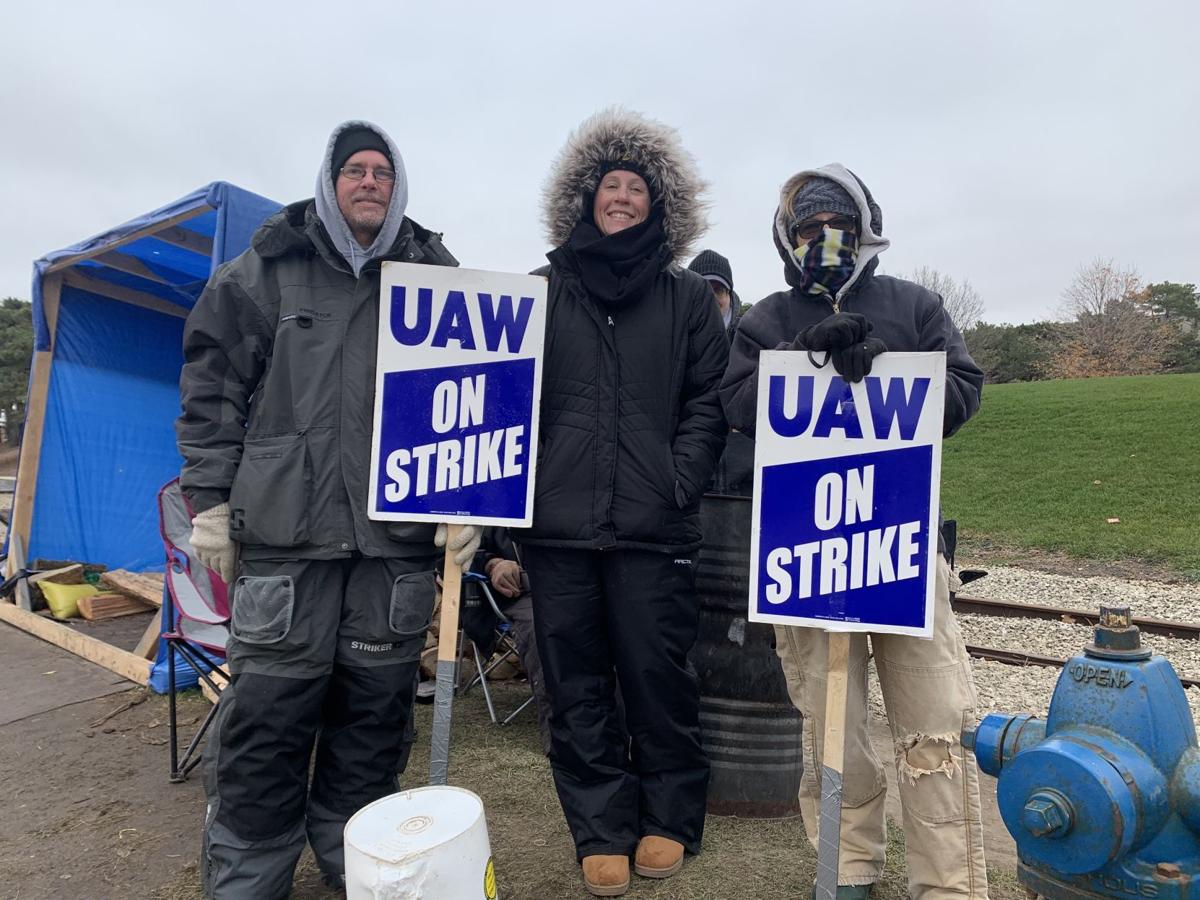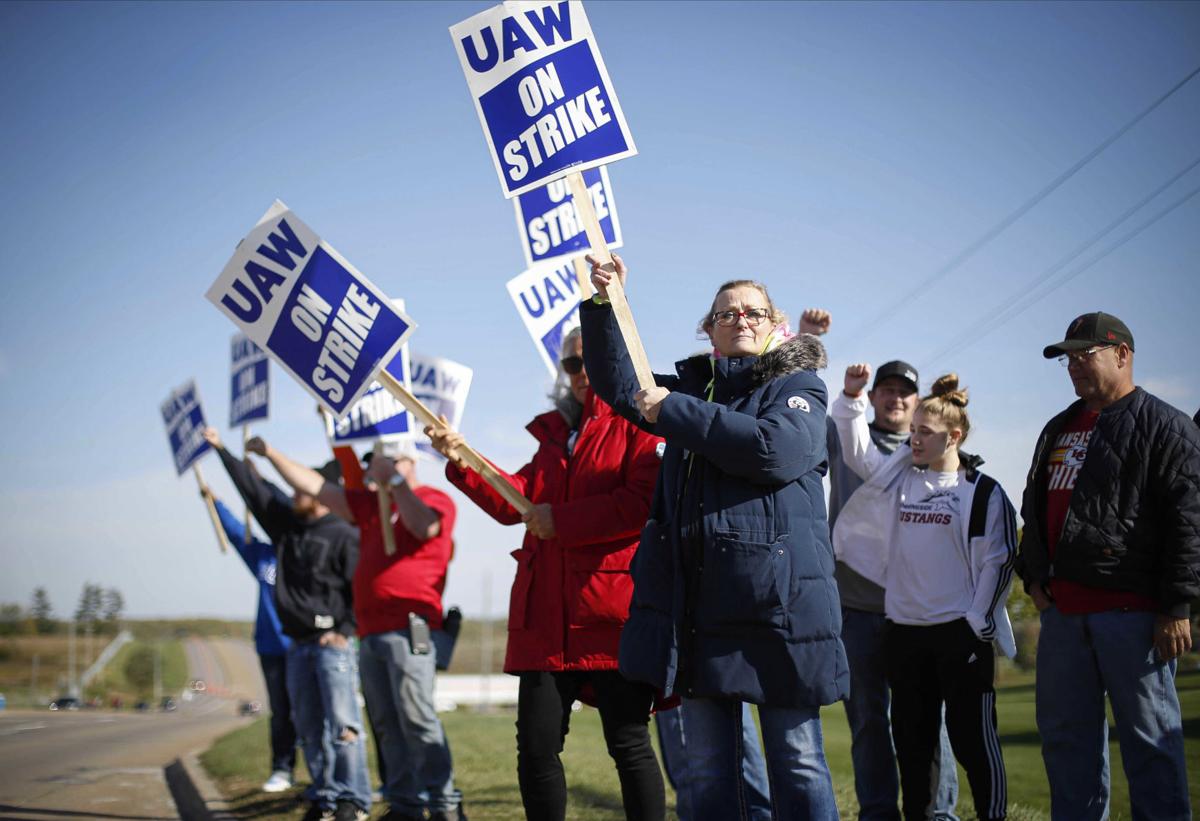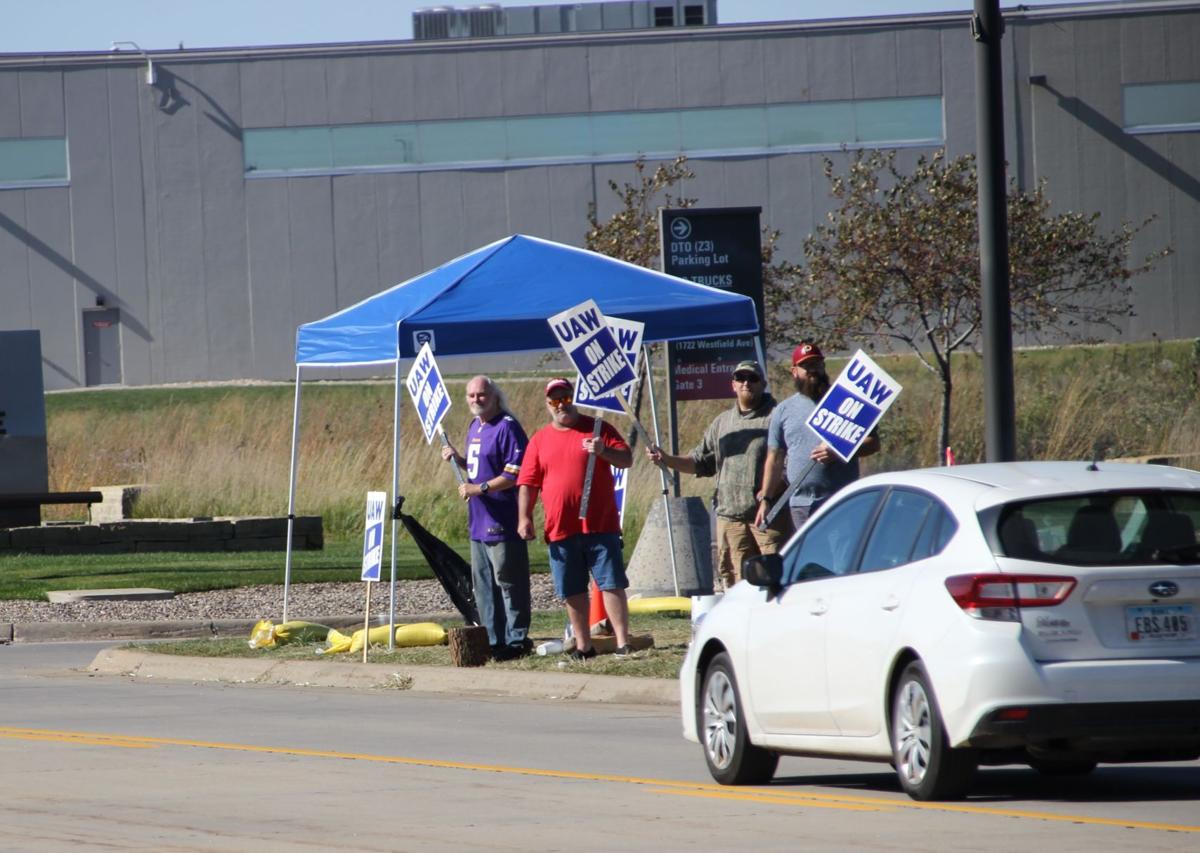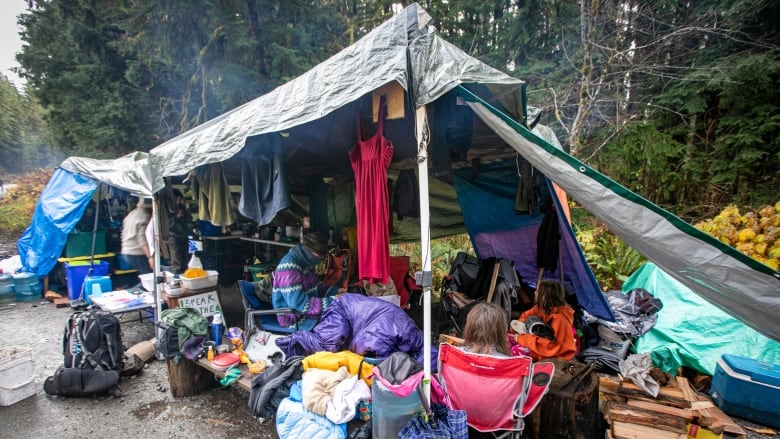Protest over Hamilton’s encampment evictions causes city-wide service disruptions
Published November 12, 2021 a
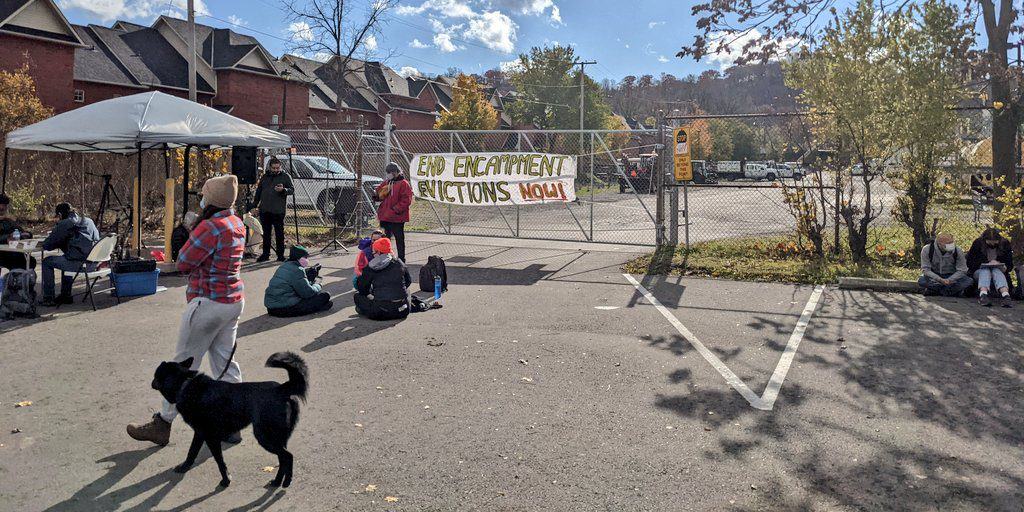
Dozen of individuals blocked the entrance to a City of Hamilton Public Works facility Friday (Nov. 12) in protest over the eviction of encampments on city propert
Members of the Hamilton Encampment Support Network set up outside 161 Studholme Rd — off of Aberdeen near Chedoke, and said they would remain there “all day.” They’re demanding an end to the encampment evictions.
The City says “approximately 30 staff and about 10 vehicles” were prevented from attending work-sites due to the protest. Staff at the Studholme building work mostly in the city’s Parks department, as well as Energy, Fleet & Facilities and golf. Some of the staff were scheduled to install the Christmas tree in Dundas on Friday, according to the City.
“WE WON!” tweeted Hamilton Encampment Support Network at around 2:30 p.m. “Thanks to everyone that joined us for our first labour stoppage picket, we shut down City facilities today responsible for carrying out encampment evictions for the day. Thank you to everyone today – we will continue to show up in numbers and keep up the fight.”
“The City respects people’s right to peacefully protest, but must also ensure the safety and respectful treatment of city staff in their workplace,” Shantz said. “The majority of staff at the location were sent home. The remaining staff were redeployed to other work and work locations today.
The clearing of encampments from city property was permitted after a Superior Court ruling on Nov. 2. An attempt by the Hamilton Community Legal Clinic (HCLC) to get an interim court injunction preventing the city from tearing down the tents failed.
Encampments and a lack of affordable, rent-geared-to-income housing have been a hot issue among residents, members of city council, social activists, and unhoused people throughout the COVID-19 pandemic.
The city maintains that it will not ticket individuals who are unsheltered unless they ignore what the city deems as “appropriate alternative options.” Then a trespass notice will be issued — placing the enforcement responsibility on the shoulders of the Hamilton Police Services.
To date, 12 individuals and couples accepted the shelter spaces that were offered, according to the City.
“At times, individuals may decline an offer of shelter initially or not arrive at the shelter for different reasons,” said Shantz. “Outreach staff remain engaged with these individuals and continue their outreach activities and offers of support with shelter, referral to community supports, and developing housing plans.”
She added, “An encampment site is only scheduled to be cleared once everyone at that location has been assessed, once everyone has been offered safe and appropriate indoor space, when available; and notice has been provided to give people time and help to collect personal belongings.”
City staff says it is planning to bring a report to the Dec. 7 Emergency & Community Services Committee that will provide more details about the planned transformation of the shelter system, capacity, and winter plans.
Demonstration at Hamilton public works yard after failed legal battle to prevent encampment removal
By Don Mitchell Global News
Posted November 12, 2021

Members of the Hamilton Encampment Support Network (HESN) gathered at the public works yard on Studeholme Road, near Chedoke Golf Course, to stop trucks they say are responsible for carrying out encampment evictions for the day.
“Since the failed injunction, we’ve seen a rapid escalation of teardowns with the idea of making homelessness disappear,” a speaker said at the demonstration.
READ MORE: City of Hamilton to resume enforcement of encampments following win in court
“Encampment residents are forced to disappear into the escarpment away from their own communities where they are in a lot more danger than where they were.”
A spokesperson for the city of Hamilton confirmed 30 staff and about 10 vehicles were prevented from attending work sites as a result of the protests.
“The city respects people’s right to peacefully protest, but must also ensure the safety and respectful treatment of city staff in their workplace,” senior communications officer Michelle Shantz said in an e-mail.
“Majority of staff at the location were sent home. Remaining staff were redeployed to other work and work locations today.”
The demonstration comes after Superior Court Justice Andrew J. Goodman ruled against a group of homeless residents seeking a permanent injunction to prevent the City of Hamilton from moving homeless residents from city parks.
The same day as the court decision, the city issued a release saying it would be resuming enforcement of park bylaws.
In making his decision, the judge said evidence brought forth by counsel at the hearing demonstrated the city “continues to undertake reasonable steps in order to make available safe shelter space and accommodation.”
Over two days, Oct. 21-22, Goodman heard verbal arguments from counsel using written testimony from the likes of doctors, residents and outreach staff connected to the encampment issue.
Counsel for the city argued that the installations in city parks were causing tens of thousands of dollars in damage to trees, grass and other permanent structures in addition to propagating safety issues, unauthorized use of electricity and calls to clean up discarded needles and drug paraphernalia.
The applicants suggested the city has not created any new shelter space for the homeless, citing recent dates in mid-October when the director of housing services stated the system didn’t have enough beds on a given night.
Since the decision, the city says outreach staff have offered 40 people from encampments spaces in shelters or hotels.
Only 12 individuals and couples have accepted the offer to date.
“At times, individuals may decline an offer of shelter initially or not arrive at the shelter for different reasons,” said Shantz.
“Outreach staff remain engaged with these individuals and continue their outreach activities and offers of support with shelter, referral to community supports, and developing housing plans.”
As of Nov. 2, the city says there are 507 emergency shelter beds in Hamilton.
The (HESN) is demanding an end to encampment teardowns — and that the resources be redirected into the creation of affordable housing.
About 30 staff and 10 vehicles were ‘prevented from attending work sites’ the city says
With winter coming soon and the teardowns of encampments continuing over the past week, the Hamilton Encampment Support Network (HESN) and other supporters of encampment residents upped the ante Friday to prevent city workers from dismantling the make-shift housing that has popped up in parks across the city.
About 30 people gathered Friday outside a city public works facility near the Chedoke Golf Course, preventing vehicles from exiting the facility.
By mid-afternoon, HESN said, workers left the facility and it closed for the day, and the network declared success in delaying evictions.
"We picked this location as a way to delay an encampment eviction, even if for a day," said HESN volunteer Eshan Merali. "We were told that evictions were going to be ramped up to the point of being completed by today."
In a statement from the city, it said "approximately 30 staff and about 10 vehicles were prevented from attending work sites" Friday, including some from parks and energy departments.
Throughout the day, some protesters played games of chess, others shared food, played music or made speeches, as they stood in solidarity with encampment residents.
HESN volunteer Merima Menzildzic said part of frustration has been over whether shelter space is available. The city has said that there are spaces, she said, but "the reality on the ground is that people are being told there are no shelter spaces," she said, adding that a lot of spaces available are not accessible for some individuals or would separate families.
Protesters were also hoping to start a dialogue with city workers. "We want to let them know that they have the right to refuse this work," said Merali.
Menzildzic agreed.
"This kind of position that they put workers in where [they] come in to remove belonging to evict people only to have the city not actually respond in a meaningful way is also work that workers can reflect on and take action to refuse to do."
Teardowns happening since court decision
Last month, five people who had lived in encampments were named in an application to Superior Court seeking an injunction to stop the City of Hamilton from tearing them down.
On Nov. 2, Justice Andrew Goodman ruled the city can enforce its bylaw against tents in public spaces, prompting disappointment from some encampment residents and from the Hamilton Community Legal Clinic.
"There remains a segment of Hamilton's population, the most vulnerable, who have nowhere else to go," the clinic's statement read.
Since then, a number of teardowns have been reported, included last weekend in Woodland Park and earlier this week at Jackie Washington Park. However, these evictions have not stopped new encampments from emerging again at the same parks, HESN says.
"We've noticed that even the encampments that were cleared last week have started popping up again," said Menzildzic, "because people don't have access to the shelter spaces."
Stephanie Cox, with the Hamilton Community Legal Clinic, shared concerns over the fact that the city does not have a plan to protect people during the winter.
"The city has not developed their winter response to homelessness policy, which is very concerning given that the cold is here and the city has been aware of their inability to meet shelter demands for months," she said in an email to CBC Hamilton.
Cox said encampment residents have reported to the legal clinic that the city's housing outreach team has not engaged them and they are not receiving notices of bylaw infraction. Instead, she said, bylaw staff enter parks, and take away tents and belongings "and the homeless person is left standing with nothing and nowhere to go."
"This is traumatizing for them and places them at risk of death for a myriad of reasons including exposure to the harsh elements and a loss of connection to doctors that provide proactive lifesaving treatment," she added. "It does not have to be this way. The city can exercise its powers to stop bylaw enforcement."
Range of work prevented
The city released a statement Friday afternoon acknowledging the actions at the public works facility, and said some of the staff whose work was prevented included those who cut grass, collect garbage in parks and workers who were due to install the Christmas tree in Dundas on Friday.
"The city respects people's right to peacefully protest, but must also ensure the safety and respectful treatment of city staff in their workplace. Majority of staff at the location were sent home. Remaining staff were redeployed to other work and work locations today," its statement read.
As for its approach for encampment teardowns, the city "continues to take into consideration the safety and well-being of individuals experiencing homelessness," it said, adding that it continues to enforce its bylaw that prohibits camping in public spaces.
"With respect to available shelter space and where individuals are going, the Housing Services' Housing Focused Street Outreach Team connects with unsheltered individuals, regardless of their circumstances, to assess their immediate individual needs and housing preferences and available supports in the community."
Since Nov. 2, according to the city, 40 people from encampments were referred to available spaces in shelters or hotels. "To date, 12 individuals/couples accepted the shelter spaces that were offered," it said.







